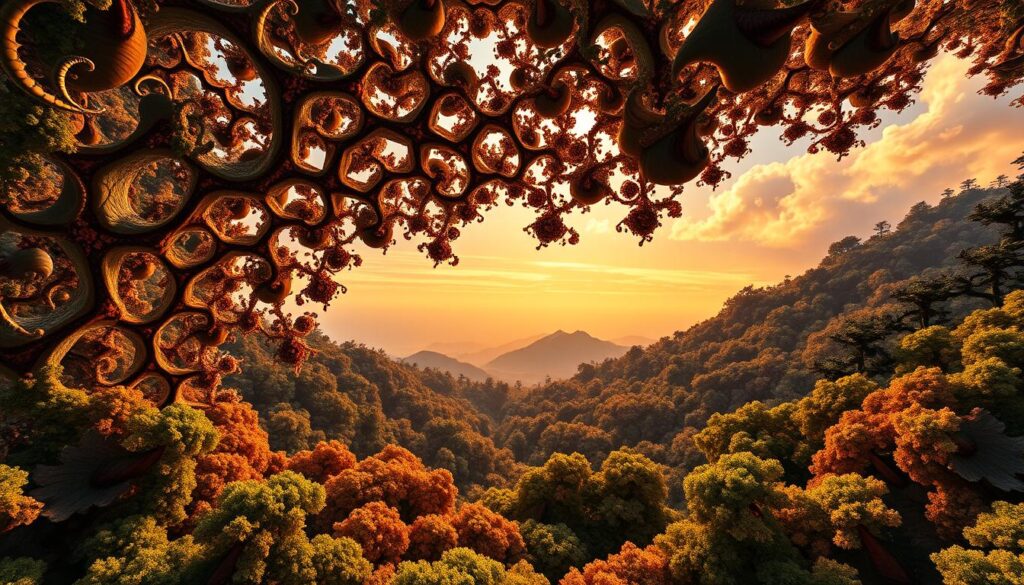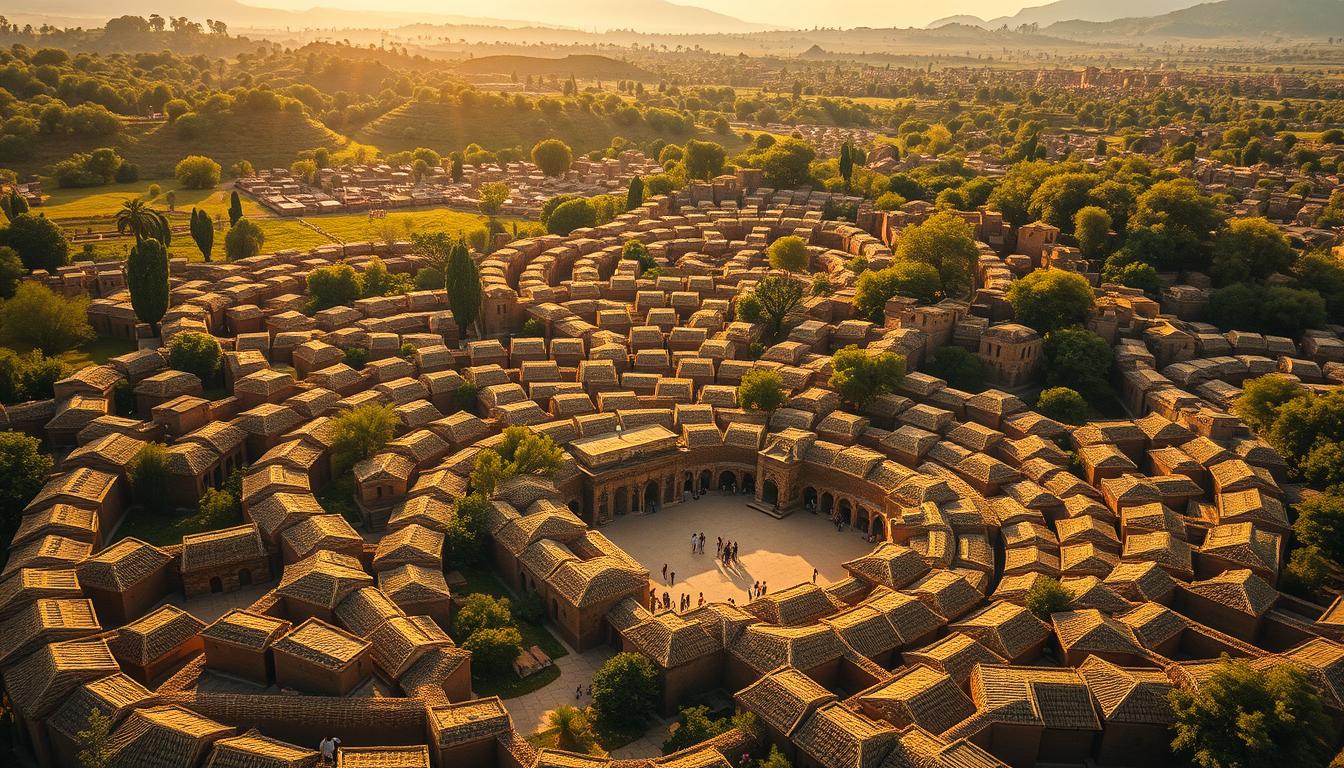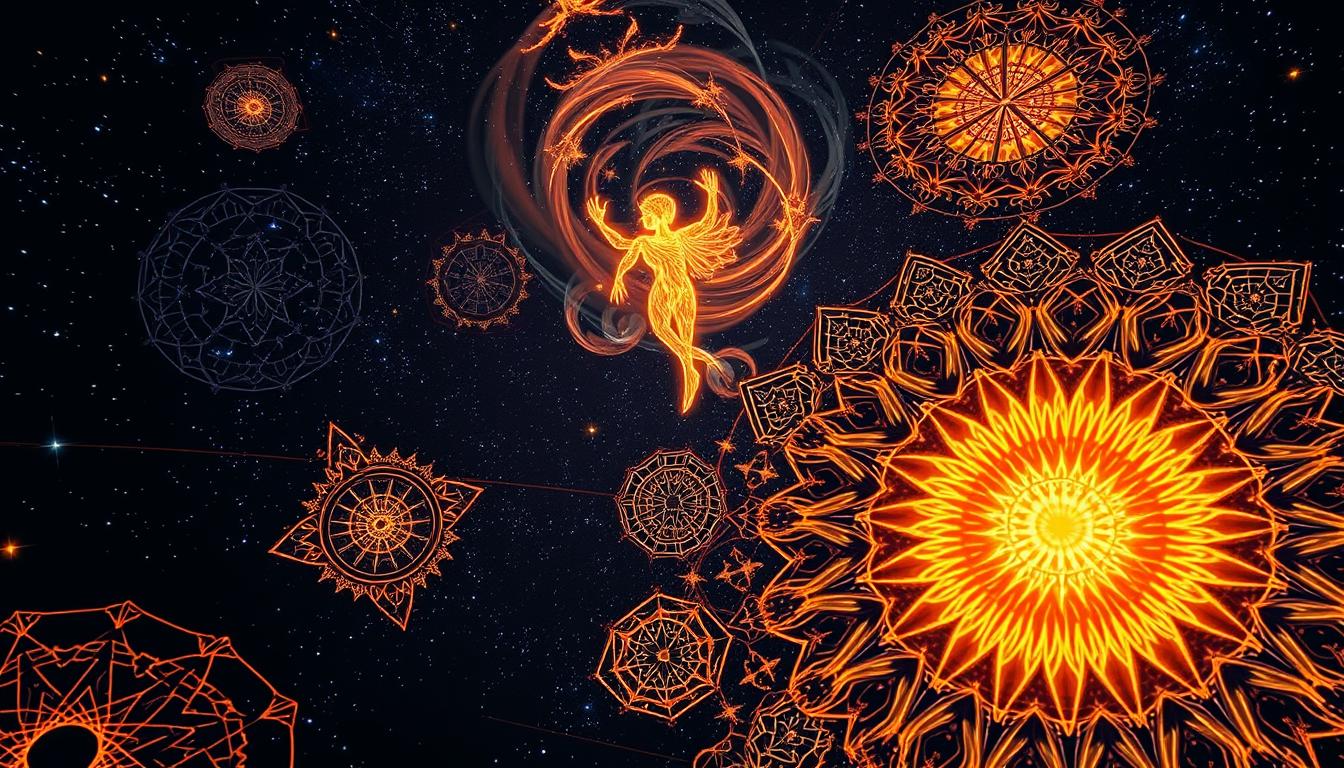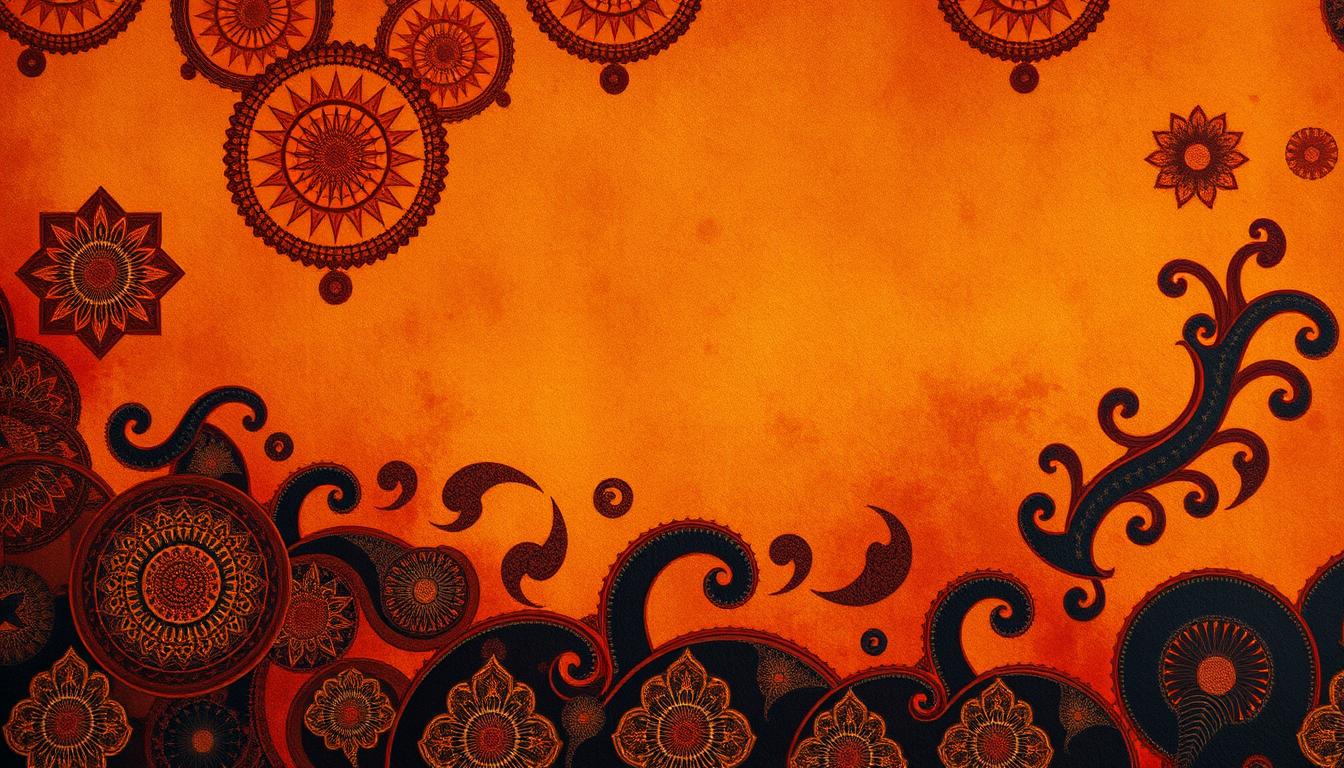Fractal art mirrors the complex patterns we see in nature. This art form shows patterns that repeat forever, making it similar to the artistic expressions in indigenous cultures. These cultures often use natural elements in their art.
The link between fractal patterns and cultural stories shows how math and culture mix. This mix gives us a deep understanding of the universe. By studying fractal art, we learn about the beauty of math. Plus, we connect to ancient knowledge and traditions.
The Essence of Fractal Art
Fractal art connects math and nature, showing the beauty in fractals’ complexity. These forms have self-similar patterns that repeat, making stunning visuals. They come from math but help us see the world in a new way.
Understanding Fractals
Fractals have geometric shapes that are endlessly detailed yet simple. You see the same patterns up close or far away. They blend order and chaos, which fascinates both mathematicians and artists.
Examples of Fractal Patterns in Nature
Nature is full of beautiful fractal patterns. Look at ferns, broccoli, tree branches, and snowflakes. They show how math shapes natural forms. These examples reveal the beauty and significance of fractals in nature.

The Connection Between Fractals and Indigenous Cultures
Indigenous cultures have always used fractal designs to show nature’s beauty. These designs also show their deep knowledge of symmetry and scale. Through these patterns, communities share their cultural identity and beliefs.
Ron Eglash’s research shows the beauty of African fractals. It highlights how natural structures and cultural expressions are linked.
How Indigenous Cultures Represent Nature
Indigenous art patterns go beyond looking good. They show a deep connection with the universe and the world around us. You can see these fractal designs in many places, like:
- Textiles with repetitive geometric shapes
- Body art that imitates nature
- Buildings designed to fit into natural settings
This way of representing things underlines the value of indigenous wisdom. It helps us understand nature and geometry better.
Fractals in African Art and Architecture
In Africa, fractals are common in clothes, village designs, and buildings. These patterns do more than look nice. They strengthen community ties and reflect the natural world’s fractal beauty. Examples include:
- Textile patterns that mimic nature, carrying deep cultural significance.
- Village and monument designs that show fractal geometry, blending in seamlessly with their surroundings.
These cultural works show that understanding and interpreting our world through fractals is an age-old tradition.
Fractal Art: A Visual Representation of Indigenous Cosmology
Fractal art tells the story of indigenous beliefs through beautiful patterns. It shows how all life is connected. These designs are more than just pretty; they help us understand different cultures.
For many indigenous people, nature is very important. Fractal art shows this through amazing designs. Each piece shares the spirit of the community. It shows how people, nature, and the universe are all linked. The designs look like things we see in nature, helping us see deeper meanings.
This art encourages modern artists to explore old wisdom. They use fractal designs to talk about who they are, where they come from, and life’s big ideas. This creates a colorful blend that respects old traditions and shares them with more people.
The Mathematical Foundations of Fractal Geometry
Fractal geometry is a fascinating branch of math. It explores complex patterns that show self-similarity and intricate details. This field looks into the math that shapes these structures. It shows the link between abstract theory and the visual world we see. By understanding these ideas, we get insights into the order in chaotic systems. Especially those patterns found in nature.
Introduction to Fractal Geometry
The late 20th century saw the birth of fractal geometry, thanks to Benoit Mandelbrot. It deals with fractals, shapes that break down into smaller copies of the whole. Fractal geometry is great at showing the complexity of natural forms. By using simple math rules over and over, one can create complex structures. This shows how fractal geometry reflects nature’s patterns.
Mathematics Behind Natural Patterns
Nature often shows us fractal structures. They show how math rules shape growth, energy spread, and efficiency. Look at tree branches, clouds, or coastlines. They all have self-similar designs. These examples underline that fractal geometry’s rules are everywhere around us. The math behind these patterns shows how complex systems keep order, despite seeming random.
Fractals in African Design
Fractals are key in African design, seen in textiles and buildings. The complex patterns share stories, linking art, society, and nature. This connection between fractals and culture is deep.
Fractals in Traditional Textiles
Fractals make traditional textiles stunning and meaningful. Take the kente cloth. Its bright colors and detailed patterns stand out. These patterns hold symbols that share social messages, blending beauty with deep cultural tales.
Geometric Designs in Architecture
African buildings show how fractals shape space and values. They feature detailed designs based on math. For example, the Logone-Birni palace showcases these patterns. These fractals mirror the community’s identity, marrying function with art seamlessly.
The Spiritual Significance of Fractals
Fractals are deeply meaningful in many cultures, showing how everything is connected. These complex patterns are like a mirror of beliefs held by native peoples. They see a link between humans and the stars. Fractals help people see the spiritual side of the world. They show our place in the universe.
Fractals as Symbols of Unity
For many native groups, fractals are symbols of being one. They repeat themselves, showing us life’s endless cycle. These patterns tell us we’re all part of something bigger.
Indigenous Beliefs About Patterns in the Universe
Native traditions often see the universe’s patterns as important. They show how everything is related. Through fractals, these ideas become clear, teaching us about balance and the web of life. They guide us on our spiritual path.
Fractal Art in Contemporary Expressions
Fractal art is advancing in today’s art scene, combining ancient designs with new methods. The blend of old styles and fresh techniques is evident in the creations of several modern artists. They find inspiration in the complex patterns of fractals seen in nature and various cultures. This mix turns contemporary art into a link that joins traditional themes with the creativity of our time.
Modern Artists Inspired by Ancient Patterns
Many artists today are diving into fractal concepts in their work. They reinterpret old patterns, making art that connects the past with the present. The revival of these concepts is seen through:
- Use of organic forms derived from fractals.
- Visual storytelling that references cultural narratives.
- Artworks that evoke emotional responses through repeating motifs.
The Role of Technology in Fractal Art Creation
Art and technology together spark new possibilities, helping artists create detailed fractal images. Digital tools have changed how art is made, giving artists more control over color, light, and shape. Exciting progress includes:
- Computer algorithms that create dynamic fractal visuals.
- 3D modeling software employed to visualize fractals in new dimensions.
- Interactive installations that invite viewers to engage with fractal designs.
Exploring Indigenous Cosmology Through Fractals
Fractal patterns show us indigenous cosmology in a special way. They blend stories and visuals together. These patterns are key to many cultures, showing how they see the universe and what they’ve learned over time. The repeating designs in fractals tell the tales and beliefs of different groups.
Cultural Stories Reflected in Fractal Patterns
Indigenous communities use patterns to share their history. These patterns are found in art, showing how everything in nature and spirit is linked. The geometric shapes speak of balance and connection, showing how everything in the world fits together.
Understanding the Universe via Indigenous Knowledge
Indigenous people have a deep understanding of the universe. Their art talks about life, balance, and chaos. Fractals are more than just decoration. They make us think about the bigger picture and our place in the universe.
The Therapeutic Potential of Fractal Art
Fractal art has a big impact on mental health. It makes people feel calm and clear-headed. Using fractal designs in art therapy helps with mental wellness. Studies show fractals reduce stress and anxiety. This connects art to healing.
Fractals and Mental Health
Viewing fractal patterns helps emotional health. People feel better and think clearer with fractal art. These patterns help you relax and be mindful. They’re great for therapy.
The Use of Fractal Patterns in Therapy and Healing
Fractal patterns help in therapy. Art therapists use them to help clients share feelings safely. They blend creativity with psychological support. This boosts emotional and mental strength.
Patients understand their feelings better with fractals. They help in personal growth and recovery.
The Future of Fractal Art and Indigenous Representation
Fractal art is key in keeping indigenous cultures alive for the future. As society grows, adding fractal geometry to art classes is crucial. This helps students understand and value cultural stories through math.
Preserving Cultural Heritage Through Art
Art tells the stories, beliefs, and values of indigenous people. Using fractal patterns, artists capture the depth of their culture. This creates a deep bond with ancestral roots and the universe.
Showing how fractal geometry connects to traditional designs raises awareness. It helps more people respect these cultures.
Education and Fractal Geometry in Schools
Fractal geometry can change art education in schools. When students make fractal art, they learn about math and connect with cultural identity. Programs that combine these topics can inspire students, especially those from minority groups.
This method boosts interest in STEM careers. It builds both artistic skills and cultural respect. Doing so makes learning more complete.
Combining Science and Art: The Intersection of Fractals
Fractals show a fascinating mix of science and art. They symbolize nature’s complex beauty and are key in scientific studies. Their patterns give insights into various phenomena, important for understanding the universe’s structure. The artistic elements in fractal research help explain complex theories to more people.
The Role of Fractals in Scientific Research
Fractals have changed how scientists model natural systems. They feature self-similarity at different scales, aiding the understanding of chaotic systems. In studying ecosystems, weather, or biological structures, fractals uncover patterns that rule these complex areas.
Art as a Medium for Scientific Representation
Fractals are more than math; their beauty inspires artists. Artists use fractals to depict scientific ideas, making abstract theories more relatable. This creative approach allows the public to connect with science, enhancing their appreciation of art and science’s bond.
Conclusion
Fractal art and indigenous cosmology together highlight a captivating mix of nature, math, and culture. This blend shows how different cultures see the universe through complex patterns. Fractal art is more than just pretty shapes; it captures life’s essence and how everything is connected.
Indigenous cosmology shows us that fractals are more than math. They are symbols of shared human experiences. They carry stories, beliefs, and values that have lasted through time. This art form shows how complex and harmonious life can be, celebrating our diverse cultures.
Fractal art is a language that brings us closer to life’s beauty and complexity. By understanding indigenous traditions, we grow to appreciate the patterns around us better. This helps bring everyone together, creating a sense of unity in our divided world.



